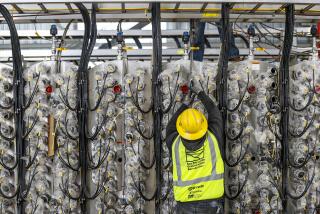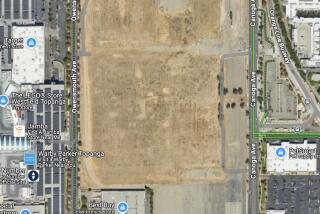L.A., 2 Groups to File Suit Over Cleanup of Rocketdyne Land
Concerned that homes may one day be built on the site of a former nuclear testing laboratory between Simi Valley and Chatsworth, Los Angeles and two environmental groups plan to sue the federal government to force a stricter cleanup of radioactive waste.
The Los Angeles city attorney’s office said it had decided to join the lawsuit against the U.S. Department of Energy, which operated the lab, because current cleanup plans could endanger city residents.
“The site is not very far from the Los Angeles city boundaries and contamination knows no borders. We are joining this lawsuit because the Department of Energy has failed in its duty to protect the public,” said Assistant City Atty. Cecilia Estolano.
For nearly four decades, U.S. agencies and private contractors conducted nuclear research and tested rockets at the 2,800-acre Santa Susana Field Laboratory. The nuclear research was terminated in 1988, and many of the facilities have since been torn down.
A small nuclear reactor that once helped power the city of Moorpark experienced a partial meltdown in 1959, releasing radioactive contamination. Numerous other pollutants also tainted the soil and groundwater, including the rocket fuel component perchlorate, which has been linked to developmental damage in children.
Now, the Department of Energy, which is responsible for cleaning up the radioactive contamination at the lab, has proposed a cleanup that it says would allow the land to be safely reused for any purpose -- including residential development.
Environmental groups, however, argue that the plan would leave behind 99% more radioactive soil than an alternative proposal that the agency rejected, and expose the land’s future residents to higher risks of cancer.
The current cleanup plan would cost $85 million, while the more thorough alternative would add $195 million.
The property is owned by Boeing Corp’s Rocketdyne division, which has successfully lobbied in recent years to defeat state legislation that would ban housing at the site. Boeing declined to comment on the possibility of a lawsuit.
The suit by the Natural Resources Defense Council, Committee to Bridge the Gap and Los Angeles City Atty. Rocky Delgadillo is scheduled to be filed today in San Francisco federal court.
It accuses the Department of Energy of failing to comply with federal environmental laws and seeks to require a more thorough assessment of contamination dangers. It also accuses the department of unlawfully reneging on a 1995 agreement to clean up old nuclear sites consistent with standards set by the U.S. Environmental Protection Agency’s Superfund program.
Joel Reynolds, an attorney for the Natural Resources Defense Council, said the Santa Susana cleanup could set a bad precedent, resulting in reduced standards at more than 100 Department of Energy sites around the country that are contaminated with nuclear waste.
“If they can get away with violating standards at Santa Susana, they will certainly try to do the same elsewhere,” Reynolds said.
Department of Energy officials dismiss assertions they have not followed environmental laws, saying they carefully considered alternatives and held months of public hearings. They also dispute claims that they abandoned the agreement to follow EPA Superfund standards.
“We meet the intent” of the EPA Superfund standard, said Mike Lopez of the department’s Oakland office, the official in charge of the cleanup plan.
“What we’re saying is, we get to the same point,” he added.
Under the Department of Energy’s proposed cleanup, the remaining radioactive contamination at the Santa Susana site would not exceed 15 millirems above the average amount of so-called background radiation most people are exposed to in daily life. But if exposed to the extra 15 millirems over a lifetime, an additional three out of every 10,000 people would die of cancer, the EPA estimates.
Under EPA guidelines, cleanups should reduce cancer mortality risks to one in every 10,000 people. The EPA has no power to compel its sister agency to do a more thorough cleanup, but has submitted letters criticizing the Department of Energy’s cleanup plan as inadequate.
More to Read
Sign up for Essential California
The most important California stories and recommendations in your inbox every morning.
You may occasionally receive promotional content from the Los Angeles Times.










